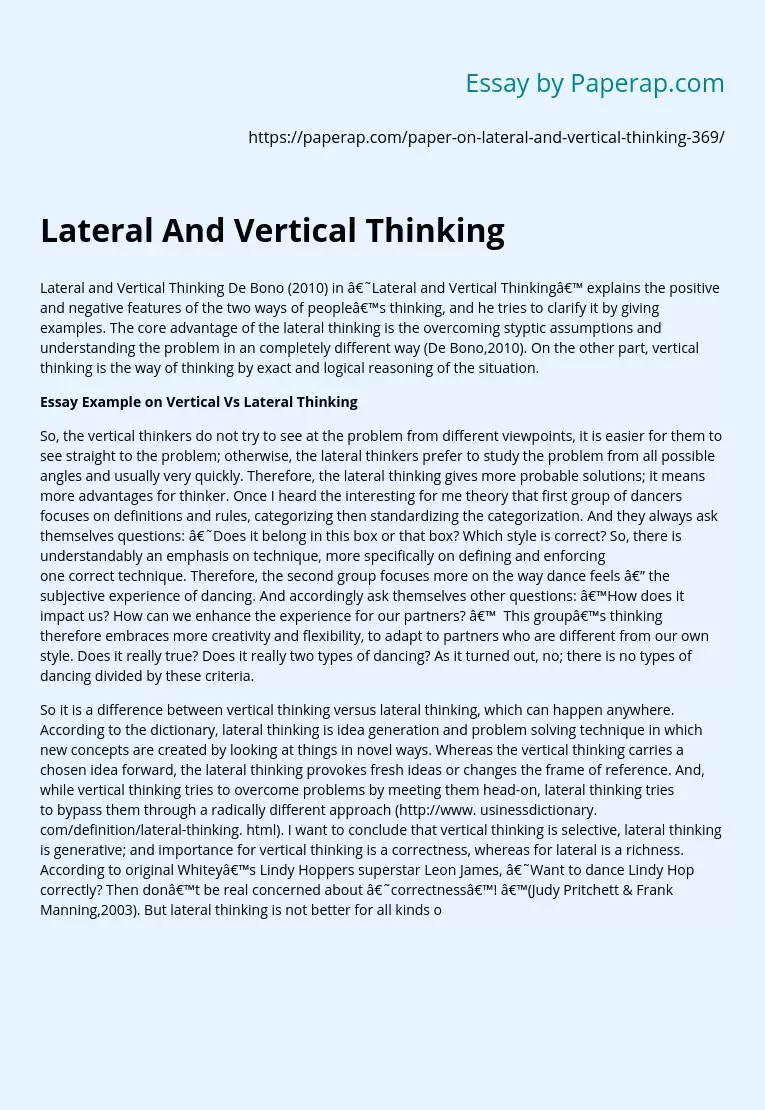Lateral and Vertical Thinking De Bono (2010) in ‘Lateral and Vertical Thinking’ explains the positive and negative features of the two ways of people’s thinking, and he tries to clarify it by giving examples. The core advantage of the lateral thinking is the overcoming styptic assumptions and understanding the problem in an completely different way (De Bono,2010). On the other part, vertical thinking is the way of thinking by exact and logical reasoning of the situation.
Essay Example on Vertical Vs Lateral Thinking
So, the vertical thinkers do not try to see at the problem from different viewpoints, it is easier for them to see straight to the problem; otherwise, the lateral thinkers prefer to study the problem from all possible angles and usually very quickly.
Therefore, the lateral thinking gives more probable solutions; it means more advantages for thinker. Once I heard the interesting for me theory that first group of dancers focuses on definitions and rules, categorizing then standardizing the categorization.
And they always ask themselves questions: ‘Does it belong in this box or that box? Which style is correct? So, there is understandably an emphasis on technique, more specifically on defining and enforcing one correct technique. Therefore, the second group focuses more on the way dance feels — the subjective experience of dancing. And accordingly ask themselves other questions: ’How does it impact us? How can we enhance the experience for our partners? ’ This group’s thinking therefore embraces more creativity and flexibility, to adapt to partners who are different from our own style.
Does it really true? Does it really two types of dancing? As it turned out, no; there is no types of dancing divided by these criteria.
So it is a difference between vertical thinking versus lateral thinking, which can happen anywhere. According to the dictionary, lateral thinking is idea generation and problem solving technique in which new concepts are created by looking at things in novel ways. Whereas the vertical thinking carries a chosen idea forward, the lateral thinking provokes fresh ideas or changes the frame of reference. And, while vertical thinking tries to overcome problems by meeting them head-on, lateral thinking tries to bypass them through a radically different approach (http://www. usinessdictionary. com/definition/lateral-thinking. html). I want to conclude that vertical thinking is selective, lateral thinking is generative; and importance for vertical thinking is a correctness, whereas for lateral is a richness. According to original Whitey’s Lindy Hoppers superstar Leon James, ‘Want to dance Lindy Hop correctly? Then don’t be real concerned about ‘correctness’! ’(Judy Pritchett & Frank Manning,2003). But lateral thinking is not better for all kinds of dancing. As I wrote, I believe that both vertical and lateral thinking are valid where appropriate.
Rule-based vertical thinking makes perfect sense for ballet and competition ballroom dance for example. You cannot hold a competition unless everyone agrees on the rules. But one of the strangest mismatches you will find in the dance world is when someone applies a rigidly vertical thinking attitude to a lateral thinking dance form, like Lindy hop, Argentine tango, West Coast Swing, salsa or blues. Those dances were born and bred in cultures which valued spontaneity, flexibility and personal variations. The original spirit of those dances is lost if their freedom is replaced by an emphasis on rules and restrictions.
So, the types of thinking have a place to be even in the dancing. The exact, logical vertical thinking is for dances with very strong techniques, but the lateral thinking gives more emotions to the dance. And always the most fascinating part of dancing is the individuality of the dancers. Keep the spirit alive. List of References Business Dictionary, nd, viewed 19 October 2011, http://www. businessdictionary. com/definition/lateral-thinking. html Marlys Mayfield, 2010, Thinking for yourself, Wadsworth, Cengage Learning, USA Judy
Lateral And Vertical Thinking. (2019, Nov 27). Retrieved from https://paperap.com/paper-on-lateral-and-vertical-thinking-369/

